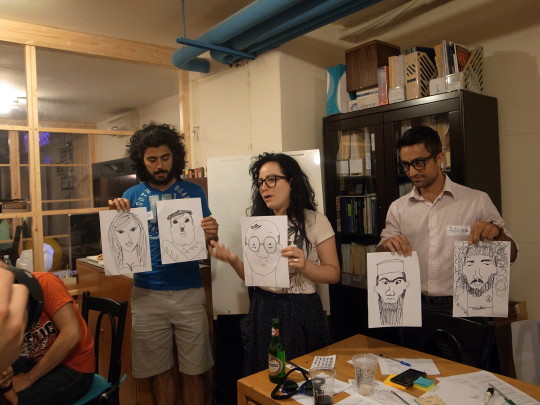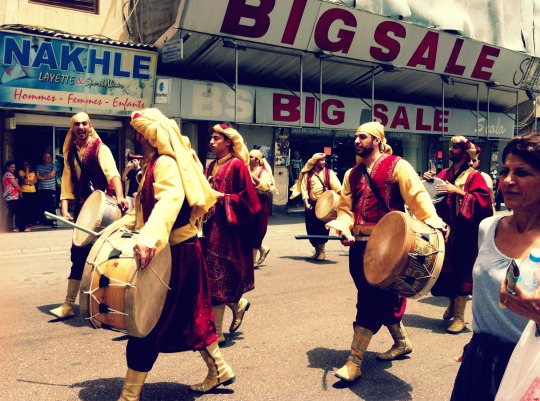Text
MiD Presents at Beirut Design Week 2013
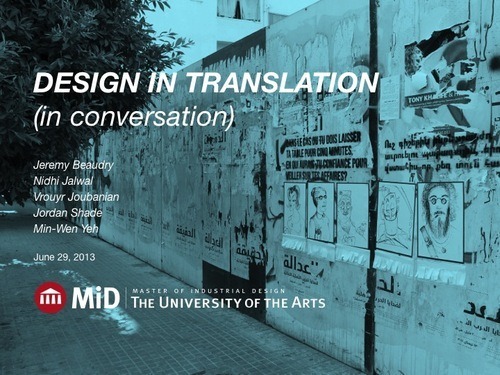
MiD program director Jeremy Beaudry and graduate students Vrouyr Joubanian, Nidhi Jalwal, Min-Wen Yeh, and Jordan Shade will discuss the work and outcomes of their month-long design research project in Beirut at Beirut Design Week on Saturday, June 29 at 1:30pm at the Lebanese American University.
From the conference program:
With the increasing complexity of social, technological, and ecological challenges, design — as a process and a way of thinking — has subsequently expanded its focus to become a leading agent of social transformation and innovation. Designers have at their disposal a number of powerful tools and methods which give them a unique ability to initiate meaningful change in communities, organizations, and businesses. But how do these design tools and methods translate across cultural, linguistic, and geographical lines? And how do the underlying assumptions and values embedded within these practices sit within in other cultural contexts? Reflecting on these questions, Program Director Jeremy Beaudry and graduate students from the Master of Industrial Design program at The University of the Arts (Philadelphia, USA) will discuss the outcomes a month-long design collaboration with Lebanese students and designers in which they together explored the shifting definition and application of design methods and tools in the Beirut context.
0 notes
Photo
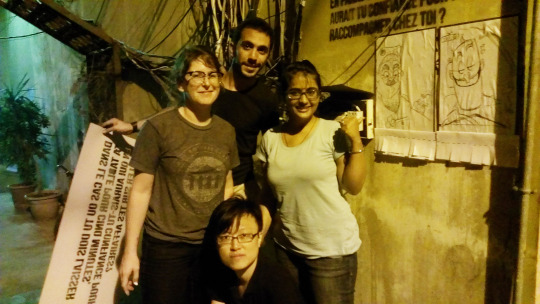

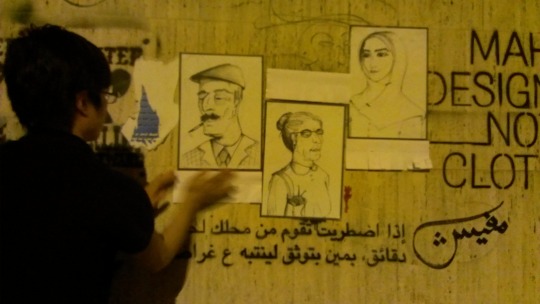
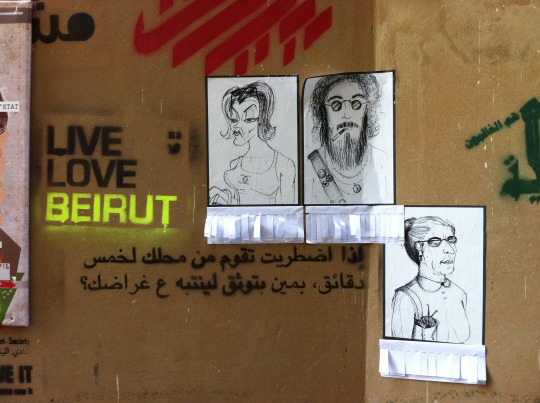
Team MID ventured with our laser-cut stencils, spray cans, posters and a bucket of glue at 3 am to post our interventions at various spots around the city.
0 notes
Text
Exploring street interventions as a design tool in Beirut
One of the boundary objects that came out of the second workshop was a very interesting street installation. The idea was to test people’s trust for specific demographics by telling them to take specific routes on mapped streets. For ex.: “I am an old Muslim woman, will you still follow me?” According to who the participant would trust, they would end up in a specific location where they could be asked some more specific questions along the lines of trust. This play-based intervention required volunteer participation and required large scale interventions painted over the streets. The given time frame of the project didn't allow us to take it forward as it was proposed.
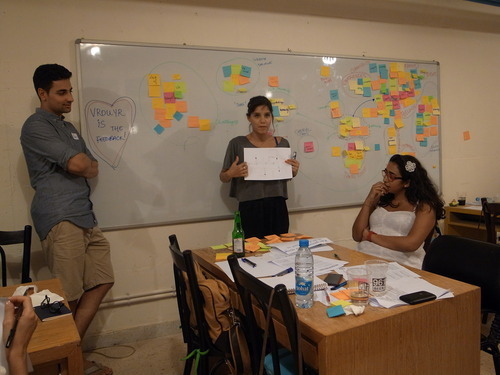
Elena presenting "Will you follow me" street intervention to the larger group
Another team wanted to explore trust in various demographics as well but a little differently. They created caricatures of certain type of population and proposed to put interviewees in specific situations and ask them to choose the person they would trust. For example, “If your car breaks down in the middle of the night, who would you trust to give you a ride back home?” However the approach was still one on one interview.
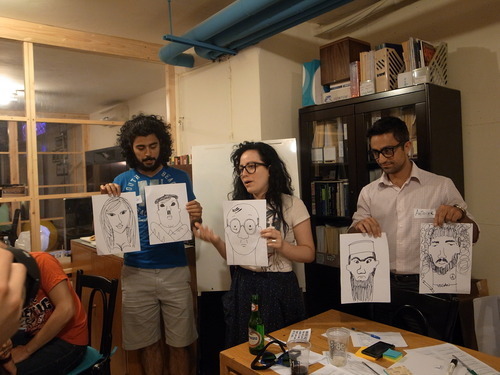
Doreen presenting the caricature idea to the larger group
The team decided to combine these two ideas into a street intervention that tests trust in various demographics using visual hints (caricatures). Two questions, "If your car break down in the middle of the night here, who would you trust to give you a ride back home?" and "If you had to leave your seat for 5 minutes, who would you trust to watch your belongings?" (near coffee shops) were painted with illustrations of a few typical characters. The illustrations are accompanied by paper tear-offs as a means of voting.

One of the interventions on the streets of Beirut
The idea is also to test voluntary participation through this graffiti/poster intervention as a boundary object in our research in Beirut. Our focus in this tool specifically was not to get data but to see how street interventions could work in the context of this city and giving people a prompt to think if not react to the issues of trust.
After that we have been trying to see if and how people interact with these public pieces. There is of course room for a lot of improvement but we are really excited to engage residents publicly in a way that may spark a conversation!
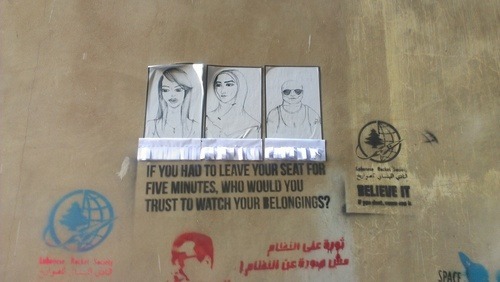
1 note
·
View note
Photo
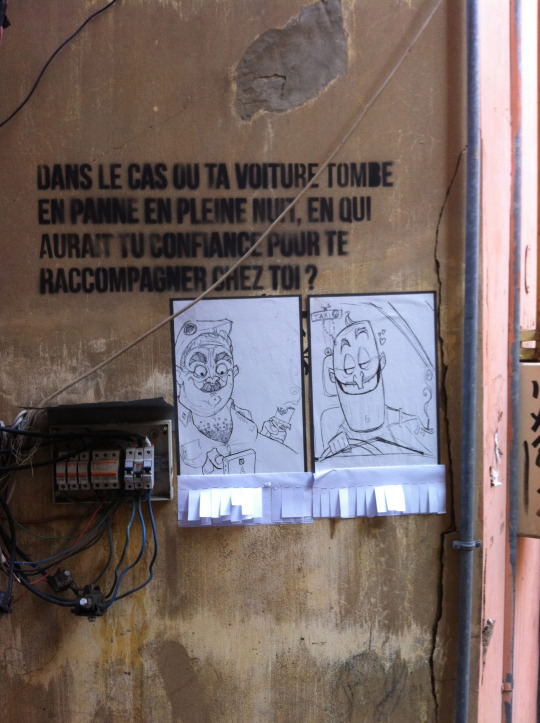
Intervention in public space exploring issues of trust. The prompt asks passersby to choose who they would ask for a ride if their car broke down.
0 notes
Photo

Click the link LIVING IN LEBANON to take the survey !!
The survey asks questions about living in Lebanon and issues related to trust. The design is based on a prototype developed during the second co-creative workshop held by MiD UArts in Beirut.
Results will be mapped out according to location and demographic, and on display at MiD's exhibition on Saturday June 29th at LAU. Check the Beirut Design Week 2013 schedule for more details.
1 note
·
View note
Text
Tools in Translation: Trust Timeline
This week the MiD designers are further refining and testing out boundary objects co-created in the large workshop held last week at Alt City.
MiD student Jordan Shade and Lebanese product designer Tatiana Toutikian, along with other teammates created an interview tool for asking focused, personal questions about trust.
During the workshop, participants wrote down words and phrases describing trust in a free association exercise, and then all of the responses were sorted as a group to define different areas or elements of trust. One of the results was how trust changes or develops over time. In response to this topic, the Trust Timeline was made: a graphic of a time line, with small color-coded pieces representing different factors of trust in a relationship. The interviewer uses this tool to ask the interviewee about a relationship she has had with an individual, an organization or even an institution such as a political party or religious sect. The interviewee chooses three or four major moments or points in time including when the relationship began and the present moment, and maps out the trust they had or didn’t have for the subject of the time line by drawing onto the image.
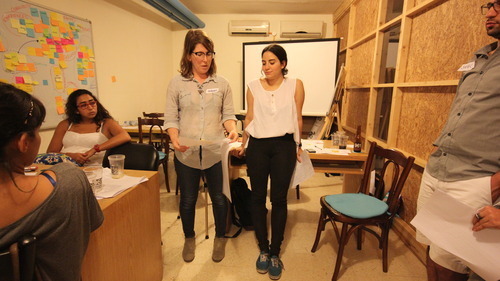
Jordan and Tatiana present the timeline tool to the other workshop participants.
Using the small color-coded pieces, which have titles ranging from “environment” to “personal quality” to “shared experience” the interviewer and interviewee describe the different points marked on the timeline. These pieces represent the factors which led to a gain or loss of trust at each moment. This activity helps the interviewee reflect on how trust was formed, and what influenced them in their feelings of trust. The interviewer uses the tool to keep the conversation focused on one individual/organization/institution and along the span of time indicated by the interviewee. This way, more pointed data can be collected about how people come to feel trust for others.
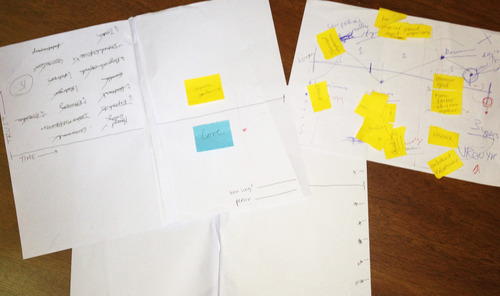
Prototype of timeline from workshop
Once the moment or point in time has been explored and described, the interviewee ranks the different factors by importance to their understanding of trust at that time. This way, quantitative data can also be mapped onto the time line via the ranking. The color-coding element also allows the time line to be read quickly in terms of what factors people value when evaluating trust or distrust.
The tool is scalable in that it can describe a relationship between two people, or a person and a large body, such as a government body or church. Based on further testing the tool might also be used on a variety of personal subjects, not only trust. Mapping the interviewees feelings to a time frame adds depth to the data and the relationship being described. The interactive nature of the tool allows the interviewee to be fluid with their thoughts, and literally place them and rearrange them on the time line for the interviewer to see and understand. The interviewer can also use the tool to check their understanding of the information they are taking in. By using the colored pieces to clearly define how the interviewee felt at different times, the data is more accurate than being directly interpreted by the interviewer.

The newest prototype being tested in an interview
Important in the sensitive nature of discussing trust in Lebanon, the Trust Timeline affords the interviewee to describe personal moments without giving too much detail about the situation, as the color-coded cards categorize different elements in the relationship. For instance, the card “emotion” or “physical object” could be used without the interviewee explicitly having to say what exact emotion or object was involved in the scenario.
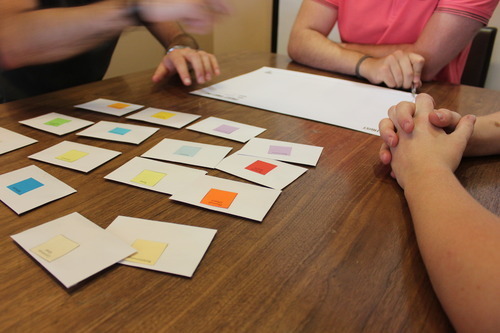
Lastly, the tool allows for the data gathered to be cross checked on many time lines, due to the method of documentation. Each time line can be compared to another, and factors that influence different relationships can be seen clearly. Over the next week, by gathering more completed time lines, the MiD designers and Lebanese designers will be able to discern patters and trends in how Lebanese citizens evaluate trust in their relationships.
The timeline and cards were translated into four languages: English, Arabic, Armenian and French, so that they may allow more people to use them with the language they are most comfortable speaking.
1 note
·
View note
Text
Thoughts from Beirut
The details that go into a language, into the manner in which people communicate, are subtle, delicate, and hard to pin down. When interacting with people from another culture how can you ever really know if they understand you, and you them? Can design overcome these gulfs, or are the differences and misunderstandings we have the keys to learning new ways of seeing the world?
We are in the middle of developing four interactive design tools to address trust in Lebanon. The tools range from being literally translated into the four common languages spoken here, to more subtle ways of adapting to the local environment. For instance, when Lebanese illustrators draw stereotypical portraits of people you might see in Beirut, the authenticity of these drawings supersedes anything we could have made, and it is only something hidden in the joining lines, the hundreds of unconscious choices the artist made throughout.
There is a plain language barrier when interviewing, or communicating with people in Beirut. Arabic, French, and Armenian words often pepper sentences and supplement words that elude the best English speakers. Only the educated classes speak English fluently, and many people are plainly more comfortable speaking their native languages. And yet there is another level not unlike the quick choices of the artist while sketching. The words unspoken, the quiet looks, the un-translatable turn-of-phrase, all escape complete comprehension.
This is where the work of creating home-grown design tools and methods in Beirut becomes fascinating. Something that seems familiar might grow out of the ideas of some Lebanese designers’ co-creative sessions, but the subtle differences are there in every decision and detail, making the tool more comprehensible and potentially successful here.
We translated one of our co-created tools, a boundary object to aid in interviews, into French, Arabic and Armenian today, and there was something stunning in the result. I couldn’t take my eyes off of this thing: so familiar and yet so foreign, and couldn’t help but think it was something very exciting and fundamental to our work here.
1 note
·
View note
Photo


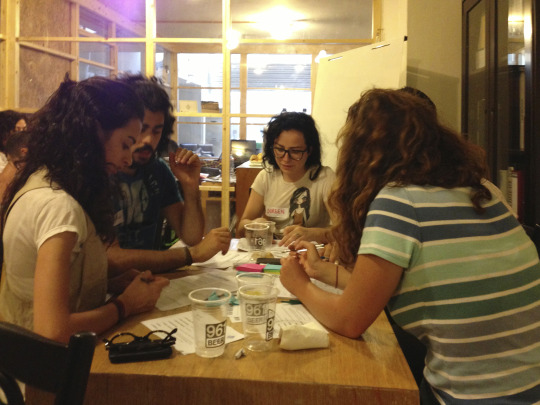


Co-Creative Workshop at AltCity on Wednesday June 12, 2013
#design#human centered design#design tools#mid#mid in beirut#mid uarts#design research#collaborative#participatory
0 notes
Photo
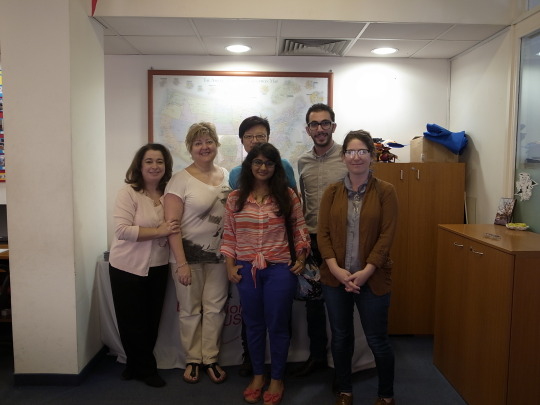
UArts MiD students visit The Fulbright office at Amideast - the people who helped send Vrouyr to Philadelphia!
0 notes
Text
Co-Creative Workshop in Beirut: June 12, 2013

Wednesday evening, sometime around 6:30pm, in a small room with plexi-glass and chip-board walls, with one chugging air-conditioner, a table of fatayer and Pepsi bottles, twenty-one people created a flurry of activity as they interviewed each other at small tables, using their hands to emphasize ideas and emotions, caught in rapt discussion, debating the meaning of trust. Then the power went out.
No one batted an eye – not a single hesitation marred the impassioned conversation. In Lebanon, when the power goes out, it is no big affair – it will be back – we trust it will be back – and that people will continue with their work, their lives, without smashing any windows, looting in the streets, or making a big to-do. The room got hot and stuffy – fast. It could barely hold twenty-one people sitting calmly still, let alone those attempting to design boundary objects addressing specific elements of trust in Beirut in a mere three hours. I found myself frequently stepping outside to fan myself, wiping the sweat from my brow. Yet the design work continued.
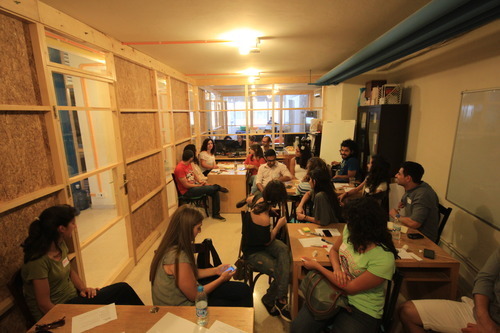
The workshop hosted by four graduate students of MiD was a clear success. Seventeen Lebanese people from various backgrounds actively took part in a very accelerated design process, in five small teams, engaged in the issues at hand, with impressive results. Our team had carefully crafted every minute of the three hours, unlike the free-flowing nature of our first exploratory workshop, here we directed the participants through ten specific activities ranging from ice-breakers, to interviews, to problem definition to scenario-enactment to prototyping.
With enough attention given to each group individually, according to their place in the process as a whole, they were able to make sense of each step and what we asked of them. It helped that we had a hand full of seasoned designers among the participants to keep things running smoothly.

In the end, five groups presented five boundary objects ranging from interview tools, to interactive street installations, to organizational games. As we further develop these prototypes over the weekend, they will be documented here, as well as the testing that follows.
By mixing the expertise and subtle understanding of our guests(/hosts) from Beirut with the goals and design research background of our MiD team, we managed a compelling co-creative session amongst those who have an interest in Beirut, change, and their fellow human beings.
0 notes
Photo

The team taking a moment to pose after a late lunch session
0 notes


